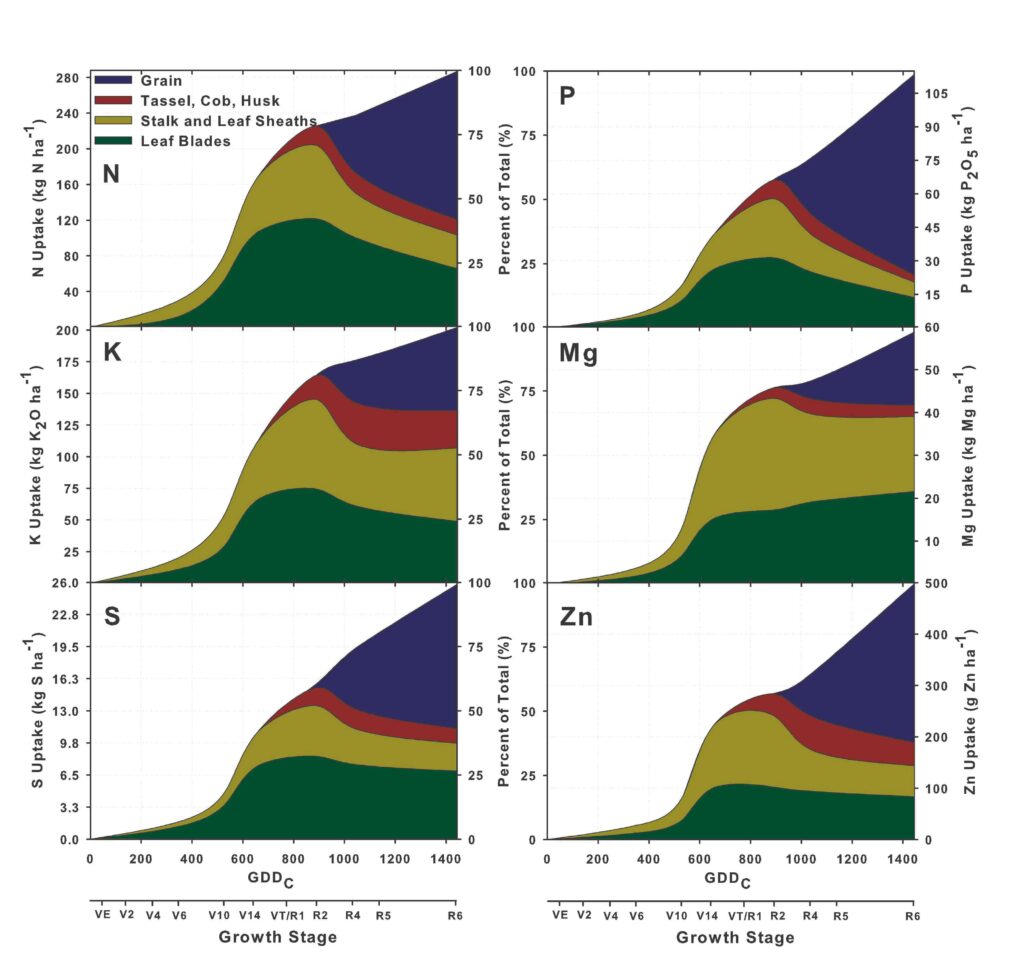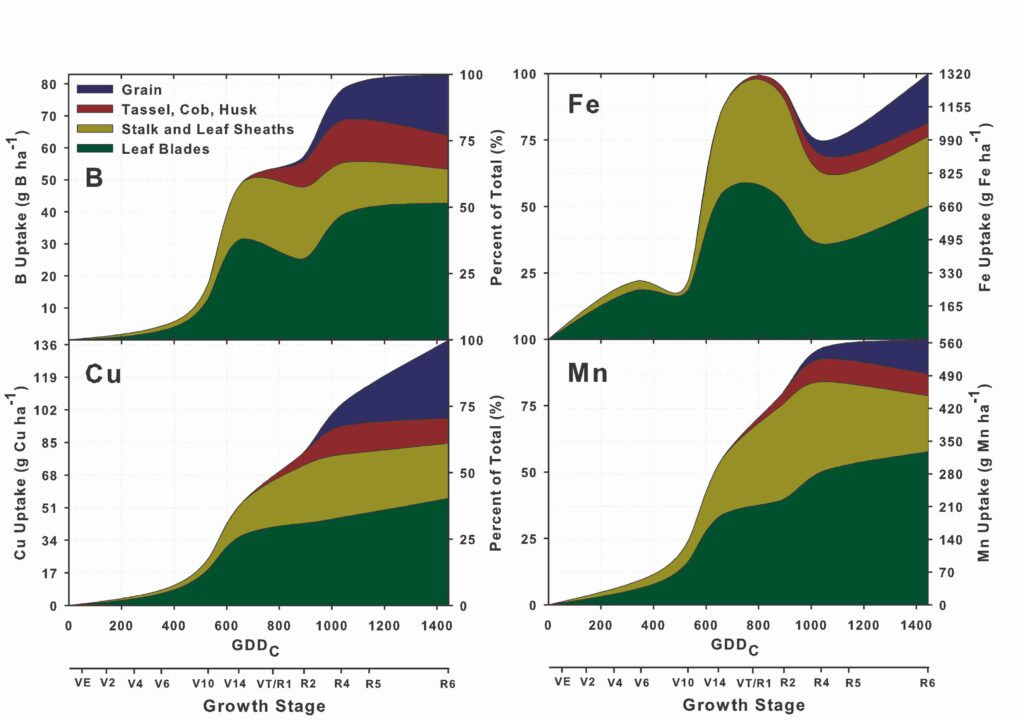Biotechnology, breeding, and agronomic advancements have propelled corn yields to new highs with little guidance as to how to fertilize modern corn hybrids to achieve their maximum yield potential. Current fertilization practices, developed decades ago, may not match the requirements of modern hybrids that contain transgenic insect protection, and which are now grown at population densities higher than ever before. A re-evaluation of nutrient uptake and partitioning can provide the foundation for fine-tuning our practices as we strive to achieve corn’s maximum yield potential. To address this need, we conducted experiments to investigate the nutrient uptake, remobilization, and removal of transgenic corn hybrids:
Table 1. Total macronutrient and micronutrient uptake and removal in Urbana, IL and DeKalb, IL (2010) for corn averaging 230 bushels/acre. Harvest index was calculated as the ratio between nutrient removal with grain and total nutrient uptake and is reported as a percent.
| Nutrient | Total nutrient uptake | Nutrient removal with grain | Harvest index |
|---|---|---|---|
| unit / acre | % | ||
| N (lb) | 256 | 148 | 58 |
| P2O5 (lb) | 101 | 80 | 79 |
| K2O (lb) | 180 | 59 | 32 |
| S (lb) | 23 | 13 | 57 |
| Mg (lb) | 52 | 15 | 29 |
| Zn (oz) | 7.1 | 4.4 | 62 |
| B (oz) | 1.2 | 0.3 | 23 |
| Mn (oz) | 8.1 | 1.0 | 13 |
| Fe (oz) | 18.8 | 3.5 | 19 |
| Cu (oz) | 2.0 | 0.6 | 29 |
Nutrient contents were determined at six growth stages among four plant fractions (leaf, stalk, reproductive, and grain tissues). To view a powerpoint which details this sampling and partitioning process, click here.
When developing fertilizer recommendations, two major aspects of plant nutrition are important to understand and manage high yield corn production: 1) the amount of a given mineral nutrient acquired during the growing season, or ‘total nutrient uptake,’ and 2) the amount of that nutrient contained in the grain, or ‘removed with grain’ (Table 1).
Further improving fertility practices require matching in-season nutrient uptake with availability of nutrients. For some nutrients (e.g., N, K, Mg, Mn, B, and Fe), as much as two-thirds of total uptake occurs during vegetative growth (Figure 1). Of critical importance is supplying N to meet corn’s peak needs of 7.8 lb N/day from V10-V14. Uptake of N does not cease at VT/R1 since as much of 50 lb N/acre is accumulated and partitioned directly into the developing seeds during grain fill (Figure 1).


Contrary to nutrients like N and K, nutrient accumulation of P, S, Zn, and Cu is equally distributed between vegetative growth and during reproductive growth (i.e., ear development and grain-fill) . Season-long supply of P, S, Zn, and Cu is imperative as we strive to maximize corn yields. Relative to total uptake, P is removed to a greater extent than any other nutrient (Table 1). Agronomic practices which do not adequately replace removed P may eventually lead to a depletion in soil fertility levels.

Although nutrient management is a complex process, improving our understanding of uptake timing and rates, partitioning, and remobilization of nutrients by corn provides opportunities to optimize fertilizer rates and application timings.
More details are found at the links below and individual uptake graphs can be downloaded from here.
Related documents and links
- A visual demonstration of our sampling process for measuring corn nutrient uptake and partitioning [.pdf article, 1.67 MB].
- Bender, R.R, J.W. Haegele, M.L. Ruffo, and F.E. Below. 2013. Nutrient uptake, partitioning, and remobilization in modern, transgenic insect-protected maize hybrids. Agron. J. 105:161-170. [.pdf article; in scientific units]
- Bender, R.R., J.W. Haegele, M.L.Ruffo, and F.E. Below. 2013. Modern corn hybrids nutrient uptake patterns. Better Crops 97 (1): 7-10. [.pdf article, in bushels /acre units]
- Below, F.E., J.W. Haegele, and M.L. Ruffo. 2009. Mineral nutrition of rootworm resistant corn. Illinois Fertilizer Conference Proceedings. Available online at: http://frec.ifca.com/2010/report9/.